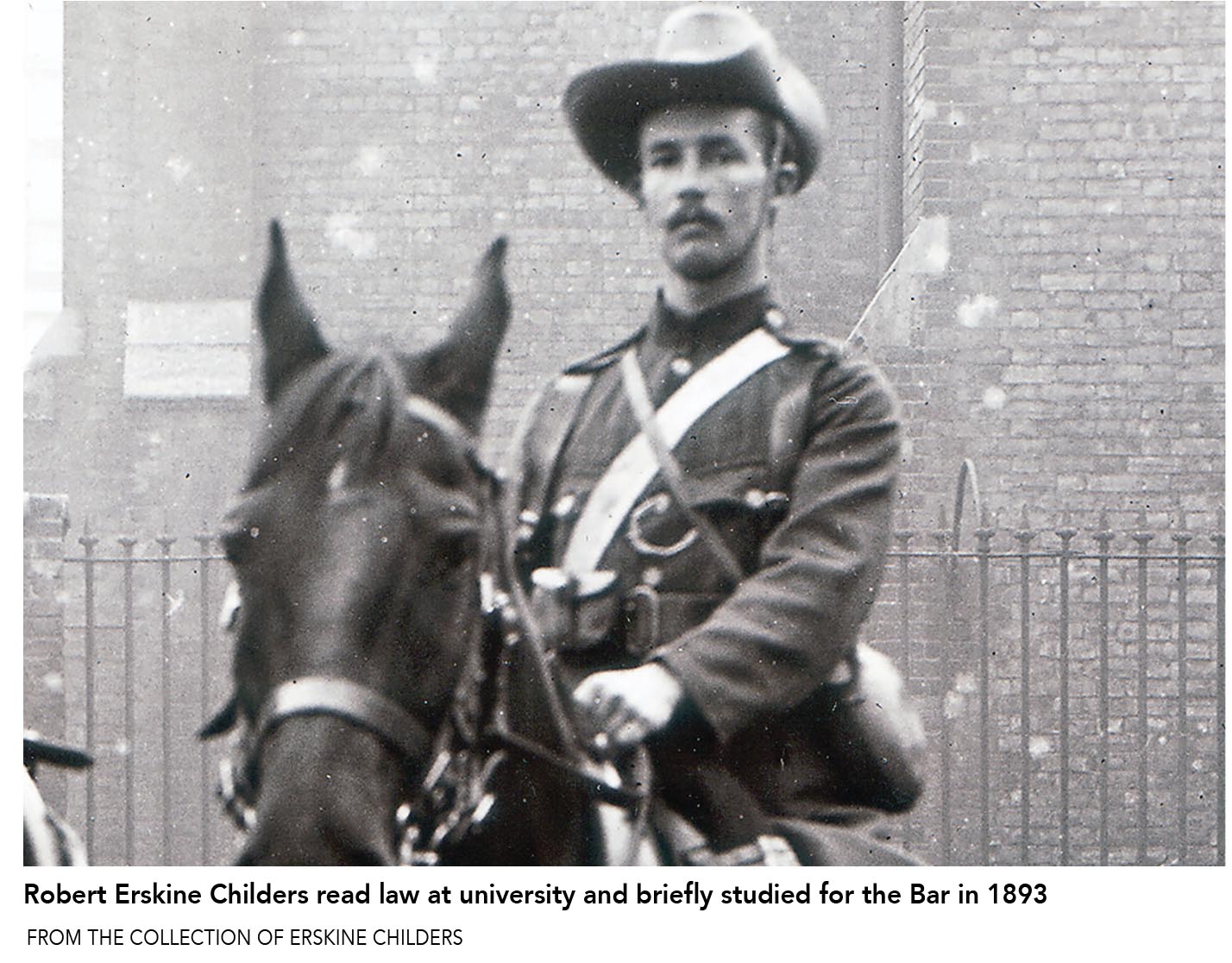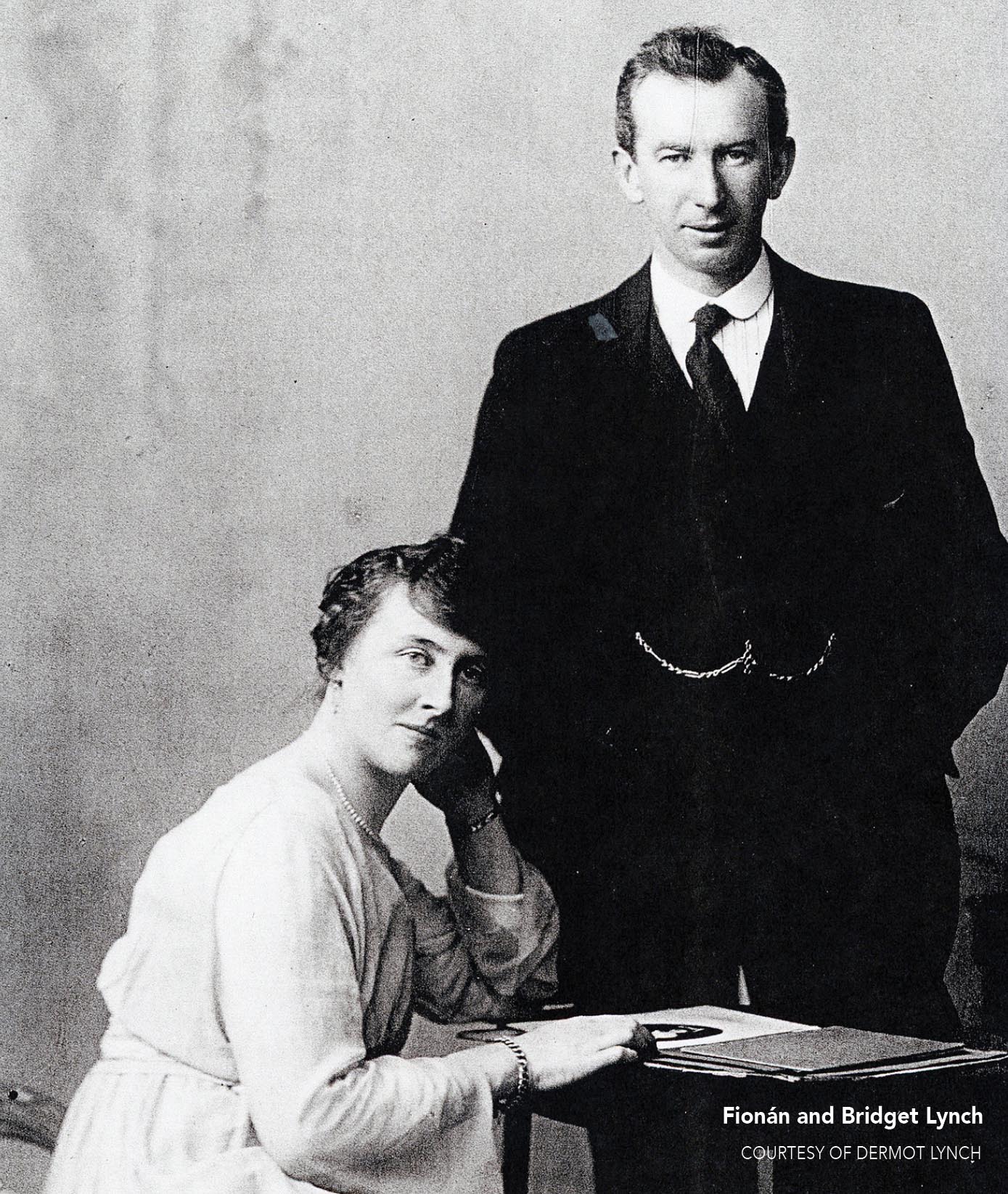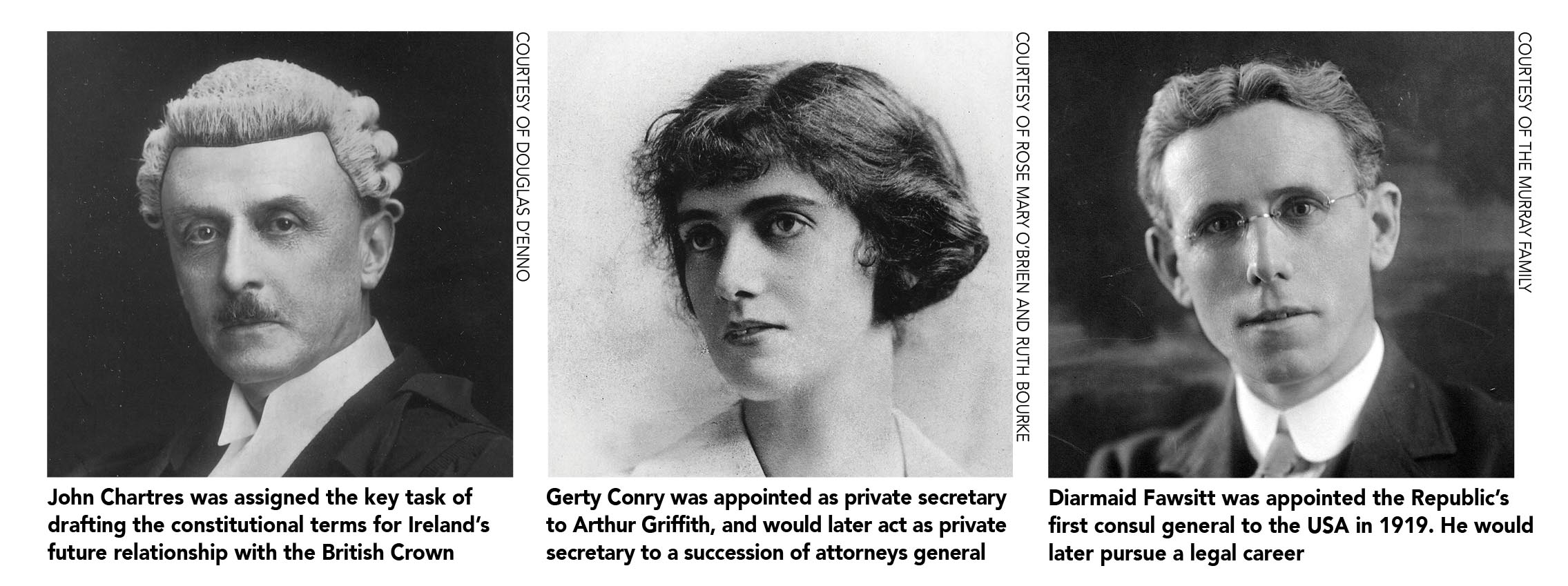After the coming into force of the truce on 11 July, de Valera led a delegation to London, meeting privately with Lloyd George on four occasions. Exchanges between Dublin and London continued through August, culminating on 7 September with a letter from Lloyd George to de Valera, inviting the Irish side to send a delegation to Inverness on 20 September.
A temporary collapse of negotiations, however, meant that Lloyd George had to issue a fresh invitation on 29 September, this time to a conference in London on 11 October. This was accepted by de Valera, and the delegation left Ireland for Holyhead on 8 and 9 October. On 6 December 1921, after two months of intense negotiations, the articles of agreement that would ultimately result in a peace treaty between Ireland and Great Britain were signed at Downing Street.
Behind the scenes
One hundred years later, only the names of the five signatories – Arthur Griffith, Michael Collins, Robert Barton, George Gavan Duffy and Eamon Duggan – are generally remembered. Yet many other Irish men and women had a role to play behind the scenes, although up to now their personal contributions have been unknown or unrecognised. Who were these people, and why were they chosen for such an important mission?
Following recent extensive research by a group of descendants, the names of around 70 delegation members and support staff who were based in London for the period of the negotiations have been identified. As well as the five plenipotentiaries, there were four secretaries and 21 advisers and staff. Nine of these – a high proportion – were (or would later become) members of the legal profession.
Five secretarial assistants provided administrative support, and there were also two chaperones, 14 bodyguards/security staff, seven dispatch carriers, and 12 key members of the household staff.
Those involved came from a variety of backgrounds, and included landed gentry, farmers, teachers, artisans, and small shopkeepers. Collectively, they represented the striking diversity of the movement for Irish freedom. Their personal stories warrant being told.
Plenipotentiary selection
The make-up of the Irish delegation was determined by the seven-member Cabinet in Dublin on 9 September and would later be sanctioned at a meeting of the Dáil on 14 September. De Valera refused to lead the deputation, instead proposing Griffith as chairman, with Collins as second in command. Collins demurred at first, feeling that he was not enough of a politician for such a task, but in the end consented.
Of the four remaining Cabinet ministers, both Cathal Brugha and Austin Stack refused, disclaiming any skill at negotiations, while WT Cosgrave was not considered. Robert Barton (minister for economic affairs), proposed by Collins, accepted with diffidence, in view of the other refusals. The remaining positions were filled by two solicitors, Eamon Duggan and George Gavan Duffy.
Duggan was nominated by Collins, who had been impressed by the skills he had demonstrated when he had accompanied de Valera to London as chief Irish liaison officer during the truce.
The son of an RIC officer, Duggan had served his apprenticeship as an articled clerk to a solicitor in Dublin, eventually qualifying in 1914 and setting up a practice at 66 Dame Street. In 1915, he took a case for tenants of the Swifte estate near Longwood in Co Meath in order to get their rights to their lands recognised.
The following year, he acted as solicitor for the next of kin during the inquest into the death of the 1916 rebel Thomas Ashe while on hunger strike. Duggan’s role in the delegation would largely involve liaison with the various British officials.
Gavan Duffy, son of the Young Irelander Charles Gavan Duffy, had been educated in France and in England. After qualifying with a solicitor’s firm in 1907, he practised in London. He defended Roger Casement at his trial for high treason in 1916, an event that affected him deeply.
Duffy was called to the Irish Bar in 1917 and, in later years, would go on to have a distinguished legal career, becoming involved in some notable constitutional cases. Appointed a judge of the High Court in 1936, he would act as an unofficial adviser to de Valera during the drafting of the 1937 Constitution and would become President of the High Court in 1946.
Delegation secretaries
At the 14 September Cabinet meeting, four delegation secretaries were appointed. Robert Erskine Childers (author of The Riddle of the Sands) had originally been proposed by Collins as a potential delegate, but de Valera had suggested him for chief secretary instead, due to his knowledge of constitutional procedure and general secretarial expertise.

Childers read law at Trinity College, Cambridge, and briefly studied for the Bar in 1893 before being accepted for clerkship in the House of Commons in 1895. He was familiar with the machinery of Westminster and had studied the political and diplomatic stratagems of earlier colonial negotiations.
John Chartres – at 59, the oldest member of the delegation – was appointed second secretary. He had entered King’s Inns in 1884, and the following year was admitted to membership of the Inn of the Middle Temple in London, where he was Powell prizeman in common law.
However, he was not called to the Bar of England and Wales until 1908, practising on the South-Eastern Circuit. Between 1912 and 1917, he wrote several law books, largely of judicial interpretations. Given his legal experience, Chartres was assigned the key task during the treaty negotiations of drafting the constitutional terms for Ireland’s future relationship with the British Crown.
In a 14 October memorandum to Griffith, he suggested a formula that he felt provided the germ of a compromise that would satisfy both sides. Part of his proposal would later be embodied in article 4 of the Treaty.
Fionán Lynch, who had trained as a national teacher, was appointed assistant secretary to the delegation, but did not attend the conference meetings, since his duties were in logistics: organising meetings, accommodation, and transport. In later years, while continuing to act as TD for Kerry, he developed a legal practice in the midlands, having been called to the Irish Bar in 1931.

Evidently held in high regard by both sides, in 1944 he was appointed to the Circuit Court bench for Donegal and Sligo by the de Valera government, even though he was a Fine Gael politician.
Diarmuid O’Hegarty was appointed as cabinet secretary to the delegation, having acted as clerk of the first Dáil and Dáil cabinet secretary, coordinating the work of various departments and having a critical role in the effective operation of government on the run.
Expert advisers and staff
Throughout late September and early October, 21 advisers and staff were appointed to the delegation. Two staff members, Joseph McGrath (later director of the Irish Hospitals’ Sweepstake) and Daniel McCarthy (who had been an effective director of elections for Sinn Féin) travelled to London in advance and rented two houses in Knightsbridge, at 22 Hans Place and 15 Cadogan Gardens.
Of the other four staff members, one was David Robinson (secretary of the Irish White Cross). He had served his solicitor’s apprenticeship in Dublin with his cousin’s firm, A&J Robinson, qualifying in 1906, but had then emigrated to Canada for some years.
There were four economic advisers, one of whom, Lionel Smith-Gordon, had studied law at Oxford. He had written extensively on the cooperative movement and, in 1919, had been appointed managing director of the newly founded Irish National Land Bank.
Another adviser, Diarmaid Fawsitt, had been appointed the Republican shadow government’s first consul general to the USA, in 1919. He would later pursue a legal career. Called to the Bar in 1928 after studying at King’s Inns, he subsequently devilled for Gavan Duffy.
In 1956, he was appointed as a judge to the Eastern Circuit. The other economics experts were academics: Charles Oldham (professor of national economics at UCD), and Timothy Smiddy (professor of economics and commerce at UCC). During the negotiations, the latter would provide Collins with a key briefing document on the issue of Irish debt to Britain.
The three financial advisers were Henry Mangan (city accountant of Dublin Corporation) who had instructed Collins in finance when he became minister, John J Murphy (deputy city treasurer of Dublin Corporation), and Joseph Brennan (secretary of the Department of Finance and later governor of the Central Bank), who would draw up eight explanatory papers outlining Ireland’s position in relation to matters such as the national revenue and liability for the imperial national debt.
George Murnaghan, who had trained as a solicitor in Omagh and was a partner in the law firm Shields & Murnaghan, was a legal adviser, while Sean Milroy, who had escaped from Lincoln jail with de Valera in 1918, acted as adviser on Ulster.
Desmond FitzGerald was appointed publicity director, with journalist Michael Knightly as press officer. Ned Broy (later to be Garda Commissioner) advised on security and acted as Collins’ personal typist and factotum, while ‘Ginger’ O’Connell, Emmet Dalton and Eoin O’Duffy (the future Blueshirt leader) were defence advisers.
The women of the delegation
No women were appointed as delegates. Countess Markievicz was originally considered by de Valera, but was not ultimately nominated. Mary McSwiney, sister of the martyred Lord Mayor of Cork and a prominent figure in the movement, was apparently judged to be too extreme. Thus, the only female members of the London secretariat were the five secretarial staff – all trusted employees.

Ellie Lyons and her sister Alice had been working for Collins in the finance office as stenographers, while Gerty Conry had been employed by O’Hegarty in the secretariat of the Dáil. Kathleen McKenna, who had worked with FitzGerald on the production of the Republican newsletter, The Irish Bulletin, was appointed private secretary to Griffith.
She would later act as private secretary to a succession of attorneys general, including John Costello, JJ O’Byrne, and the later Chief Justice Conor A Maguire.
The oldest of this group, Lily O’Brennan (an executive member of Cumann na mBan and sister-in-law of the executed 1916 leader Eamon Ceannt) had been part of the July delegation to London led by de Valera.
The wives of two plenipotentiaries also had a role to play: May Duggan and Bridget Lynch were appointed by the Dáil as chaperones to the five single women, and also acted as hostesses for the delegation.
Security and dispatch carriers
Security was a major concern, including the fear of hired assassins. For his protection in London, Collins placed his trust in the members of his band of young and devoted gunmen, known as ‘The Squad’ – four of whom he brought over specially to act as his bodyguards.
Kathleen McKenna, in her memoirs, would later describe them as “jovial boisterous men who preferred horseplay to formalities”. For additional security, eight members of the London IRA, trained and trustworthy men, acted as guards for the two London houses.
Since the Irish side didn’t trust the English postal system, confidential communication either within London or with the Cabinet in Dublin had to be transmitted by couriers. While most were former members of Collins’ intelligence staff, two were women.
Molly Flannery Woods, a well-known Sinn Féin activist, travelled over to London on at least three occasions, accompanied by her 15-year-old daughter Maureen, who carried dispatches destined for Hans Place stitched into her fur collar.
The 17-year-old Seán MacBride, whose later public career would form a central part of the history of mid-20th century Ireland, was officially listed as a ‘messenger’ for the delegation. Son of the executed Major John MacBride and his wife Maud Gonne, he was already an able guerrilla fighter by 1921, and he was personally asked by Collins to accompany the delegation to London.
During the negotiations, MacBride travelled to Dublin by the night mail – an arduous journey of 11 hours – at least twice a week, delivering dispatches directly to de Valera, as well as private letters from Collins to his IRB friends.
MacBride would go on to study law at UCD in 1924 and was called to the Bar in 1937. As a barrister, he frequently defended IRA prisoners of the State, and would later be appointed secretary general of the International Commission of Jurists.
Household staff
Since the senior domestic staff members in the two houses would be in close contact with the delegates, it was essential that trustworthy people be hired for these positions. Recruited in Dublin, they included the housekeeper of the Westbrook Hotel, as well as staff from the Gresham Hotel.
Collins particularly asked that some of the people who had helped him while he was on the run be included, and specifically invited John O’Brien (head wine waiter at the Gresham) and his brother Eddie, allegedly to ensure that he was not poisoned during the negotiations.
The cook, Mary Folkard from Oldcastle, Co Meath, was a source of fascination to both British and US journalists, who termed her “the mother of the whole party” and wrote: “It’s said in Downing Street that it’s her seasoning puts so much pep in the Irish delegates.” Her views on cooking, particularly potatoes, were eagerly sought.
The junior domestic staff – housemaids, assistant cooks, cleaners, and others – were recruited from some of the London-Irish clubs. Evidently, an Irish atmosphere prevailed below stairs, with the staff even holding a Hallowe’en party in the kitchen on 31 October.
Human cost
On 7 December 1921, the day after the signing, the Irish Independent appeared to recognise the human cost behind this accomplishment, stating: “It will be for historians to chronicle the valiant and persistent efforts, the ceaseless mental and physical strain, and the stupendous responsibility of the ordeal.”
A century later, it is appropriate to recognise the contributions of all involved, particularly those who worked quietly in the background in the hope of creating an independent and viable state, and who helped to turn the unlikely proposition of a Treaty agreement in October 1921 into reality on 6 December.
Fiona Murray is a native of Cork and a granddaughter of Judge Diarmaid Fawsitt. An Oxford history postgraduate, she is co-editor of a recent book about the members of the delegation. The Men and Women of the Anglo-Irish Treaty Delegations 1921 (Laurelmount Press, 2021) is written and produced by descendants as a limited commemorative edition. It is not currently for sale, but copies are available in local libraries throughout Ireland. A copy has also been donated to the Law Society Library.
Read and print a PDF of this article here.